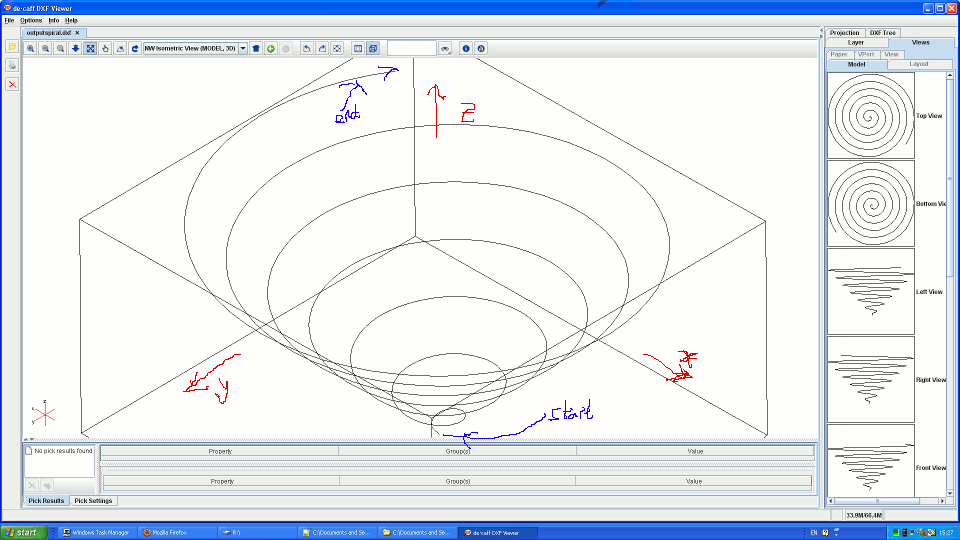Generating and Displaying 3D Vector-format files

The first example is shown here in a parallel-projected spiral form using dxfviewer-swing.jar. It can be scaled, translated and rotated on-screen in real-time.

The first example is shown here in a parallel-projected spiral form using dxfviewer-swing.jar. It can be scaled, translated and rotated on-screen in real-time.
xs =0: ys =0: zs =0
for i =1 to 40 step 0.02 ' about six revolutions- 40 radians.
xf =i *sin( i)
yf =i *cos( i)
zf =i
call makeLine xs, ys, zs, xf, yf, zf
xs =xf: ys =yf: zs =zf
next i
This rotates a point around a circle of steadily increasing radius, ie ( r sin( i), r cos( i)) while steadily moving along the z-axis.
Vector specification of a 2D or 3D object enables its reconstruction on a screen at full resolution even when magnified. Rather than invent my own formats, I use SVG files for 2D objects and now a simple early AutoCAD format for 3D objects. It is very forgiving- you can use LF or CRLF; leading spaces are optional; etc. But there is no guarantee that all- or even most- DXF viewers will not barf at it...
DXF files can be plain-text. A number signals what the next line will hold- eg 999 that it is a REM line, 0 that it is a descriptor. 10, 20 and 30 precede the x y and z-start values. 11, 21 and 31 the x, y and z-finish values. The DXF file for the above curve is ...
0 SECTION 2 HEADER 999 DXF file created by JohnF. 999 Data calc'd by Liberty BASIC 0 ENDSEC 0 SECTION 2 TABLES 0 ENDSEC 0 SECTION 2 BLOCKS 0 ENDSEC 0 SECTION 2 ENTITIES ...... everything before here is set-up preamble...... 0 ...... here we specify the start and end of first line-segment as ( x, y, z) LINE 8 0 10 0 xs =0 20 0 ys =0 30 0 zs =0 11 1.67685511 xf =1.676.. 21 0.60517204 yf =0.605... 31 1 zf =1 0 LINE ............................ etc for all the other segments etc ............................ 0 ENDSEC 0 EOF
This was all stimulated by discovering that a freely-available JAVA jar-file could display the results and rotate them in real-time.
Code for this version follows. I'd usually save & re-load the preamble as a file. Many things still to try, including file-selectors & GUI text-editor front-end to accept the code-section that creates the paths & code to run/evaluate it and display.
nomainwin
LF$ =chr$( 10)
open "outputspiral.dxf" for output as #outFile
preambleDXF$ =" 0" +LF$ +"SECTION" +LF$ +" 2" +LF$ +"HEADER" +LF$ +" 999" +LF$ +_
"DXF file created by JohnF." +LF$ +" 999" +LF$ +"Data calc'd by Liberty BASIC" +_
LF$ +" 0" +LF$ +"ENDSEC" +LF$ +" 0" +LF$ +"SECTION" +LF$ +" 2" +_
LF$ +"TABLES" +LF$ +" 0" +LF$ +"ENDSEC" +LF$ +" 0" +LF$ +"SECTION" +_
LF$ +" 2" +LF$ +"BLOCKS" +LF$ +" 0" +LF$ +"ENDSEC" +LF$ +" 0" +_
LF$ +"SECTION" +LF$ +" 2" +LF$ +"ENTITIES" +LF$
#outFile, preambleDXF$;
xs =0: ys =0: zs =0
for i =1 to 40 step 0.1
xf =i *sin( i)
yf =i *cos( i)
zf =i
call makeLine xs, ys, zs, xf, yf, zf
xs =xf: ys =yf: zs =zf
next i
terminateDXF$ =" 0" +LF$ +"ENDSEC" +LF$ +" 0" +LF$ +"EOF" +LF$
#outFile, terminateDXF$
close #outFile
run "dxfviewer-swing.jar outputspiral.dxf"
end
sub makeLine xs, ys, zs, xf, yf, zf
#outFile, " 0" +LF$
#outFile, "LINE" +LF$
#outFile, " 8" +LF$
#outFile, " 0" +LF$
#outFile, " 10" +LF$
#outFile, " " +str$( xs) +LF$
#outFile, " 20" +LF$
#outFile, " " +str$( ys) +LF$
#outFile, " 30" +LF$
#outFile, " " +str$( zs) +LF$
#outFile, " 11" +LF$
#outFile, " " +str$( xf) +LF$
#outFile, " 21" +LF$
#outFile, " " +str$( yf) +LF$
#outFile, " 31" +LF$
#outFile, " " +str$( zf) +LF$
end sub